Perl6 PowerPoint PPT Presentation
Title: Perl6
1
Perl6
- Michael Bryson
- Mark Staton
- Alex Varghese
2
Overview
- Perl stands for practical extraction and report
language - Was written as a language to scan text files,
extract information from those files, and print
reports based on that information
3
History
- Perl1 was written around 1987.
- Perl1 was mainly derived from C and to a lesser
extent sed, awk, and the UNIX shell. - Perl1 was written for the file manipulation
discussed earlier.
4
History (cont.)
- Over the years, there have been many improvements
in the language. - Perl now supports modularity and object-oriented
programming. - Perl6 is the latest version and is a ground-up
rewrite of the original source codes from
versions 1 through 4.
5
History (cont.)
- The evolution of Perl to the present day Perl6
allows programmers to perform or use - Quick prototyping
- System utilities
- System management tasks
- Database access
- Graphical programming
- Networking
- World Wide Web programming
6
Interpreter/Compiler
- Perl is an interpreted language. This allows
one to write programs without an intermediate
compilation step. Not having a compilation step
allows a programmer to experiment and test/debug
quickly. Perl has also become a great
replacement for shell scripting.
7
Syntax
- represents any scalar value
- _at_ represents a list
- represents a hash or associative array
- You always need for any block in Perl. i.e.
after an if statement - There are two sets of comparison operators. One
set is for strings and the other is for numbers.
8
Parallel Data in Perl6
- Junctions are a parallel scalar data-type, to be
introduced in Perl 6 - Four types of junctions
- Disjunctions
- Conjunctions
- Abjunctions
- Injunctions
9
Disjunctions (any)
- anyvalue any(_at_list_of_values)
- print A number is too large if anyvalue gt 10
- can also be defined using binary operator ()
- anyvalue first second
- third
- anyvalue fourth
10
Conjunctions (all)
- allvalues all(_at_list_of_values)
- print Must have positive number(s) if
allvalues lt 0 - can also be defined using binary operator ()
- allvalues first second
- third
- allvalues fourth
11
Abjunctions (one)
- onevalue one(_at_list_of_values)
- print There is exactly one zero if onevalue
0
12
Injunctions (none)
- novalue none(_at_list_of_values)
- print All negative numbers if novalue gt 0
13
More Junctions
- Junctions can also be used implicitly
- print all numbers must be positive if abc
lt 0 - Junctions are simply scalars
- if (my_equals(value, any(_at_other_values)) ...
- Can be used for type declarations
- my CarTruck x
- my CarRedObject y
- my none(Truck) z
- Allows for easy parallelization
- if( sqrt( any(_at_some_numbers) ) gt 5 ) ...
14
Comparisons
- Perls expression syntax corresponds closely to
C. - If you have experience with C or using UNIX, it
is relatively easy to learn Perl. - On the surface, Perl and TCL are very similar.
However, it is not until one is writing more
complex programs and code that the differences
become apparent.

